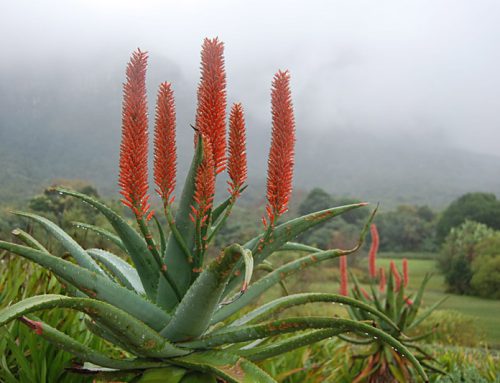 Harpuis is a species close to my ‘hearth,’ for one of its many species grows on our farm in the Sneeuberg mountain range on the Great Escarpment of the Karoo.
Harpuis is a species close to my ‘hearth,’ for one of its many species grows on our farm in the Sneeuberg mountain range on the Great Escarpment of the Karoo.
Should you happen to see me running across the veld here, brandishing a burning bush, please understand I am not performing some netherworld ritual, nor trying to set the veld alight. What I’m doing
is re-enacting an ancient fire-bearing tradition to see how long a burning stem of harpuisbos might last.
Rich in resin, it has the same long-burning effect as a candle and it is thought that the Khoisan might have used it as such so that they did not have to make their evening fire from scratch. (They called the resin bush nu-nu and t’gnu. Considering that harpuis is one of a few resin plants in Southern Africa, it is likely the Khoisan were referring to this species.)
Its long-burning quality is still used today, something medicinal plant specialist Professor Ben-Erik van Wyk observed in the Piketberg area. A man working on a wheat farm showed him how they take a long, thin stem of wit-droog harpuis, set it alight and use this one stem as a firelighter for the whole day to burn off the wheat stubble.
In addition to its fire-holding quality, harpuis is also an important Khoisan and Cape Dutch remedy for wounds, sores, burns and skin conditions. The resin contains terpenoids that have antimicrobial and antiseptic qualities, making it an early form of Dettol. They would cut the stem of the plant to ‘wound it’ so that the plant released the resin it uses to protect itself and cover its own wound. The resin would be harvested and applied
to the skin.
Another medicinal use for harpuis that is documented in a publication called Kruiterate van die Montagu Museum (Herbal Remedies of the Monatagu Museum) is the use of its resin and leaves to make a tea for back problems. This is the only record of its internal medicinal use, documented by a man known as Oom Kobus. Kobus Kriel from Pietersfontein near Montagu, now deceased, spent his whole life collecting anecdotes from traditional people and bossiedokters (bush doctors) concerning their use of indigenous medicinal plants and herbs. This information forms the basis of the publication.
We are fortunate to have the writings of a handful of people through the centuries who recognised the priceless worth of our indigenous plant legacy and its associated medicinal uses.
One of the first people to document harpuis was William John Burchell, English explorer, naturalist, artist and author, who journeyed through South Africa between 1810 and 1815, collecting over 50 000 plant specimens.
Burchell’s collection is housed in the herbarium at Kew Gardens in London and it is highly likely that several harpuis species are included, since he documented how the resin that exudes from shrubs named ‘Harpuis‑bosch’ was collected.
All who have documented harpuis describe its distinctive golden spray of flowers, something that earned the harpuis species that grows in Clanwilliam the name Speciosissimus, meaning ‘very beautiful’.
Farmers do not find harpuis beautiful because it takes over where overgrazing has occurred, but this would not have been a concern for Burchell. More likely, the golden flowers would have reminded him of his lost love, Lucia Green. He had faced strong disapproval from his parents when he broached the idea of an engagement to her, but he persisted in his love and, in his mid-twenties when he took up a post as schoolmaster and botanist on St Helena, Lucia sailed from England in 1807 to marry him.
Upon her arrival she announced a change of heart, and married the captain of the ship on which she had journeyed instead.
A broken-hearted Burchell, who never married, departed for Cape Town in 1810. He had a wagon specially built for him and was assisted by six Hottentot servants as he trekked into the interior.
Perhaps he thought it would help him to forget. But not even the harpuis resin managed to heal his wounded heart as he witnessed its golden bouquet, and longed that life had turned out differently with Lucia.




